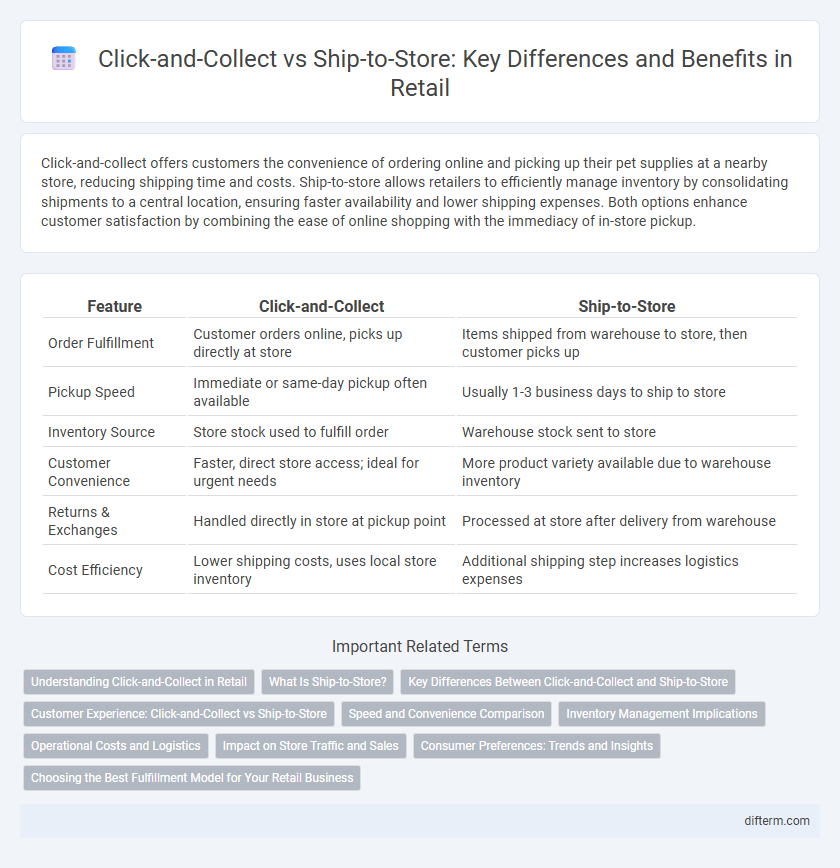Click-and-collect offers customers the convenience of ordering online and picking up their pet supplies at a nearby store, reducing shipping time and costs. Ship-to-store allows retailers to efficiently manage inventory by consolidating shipments to a central location, ensuring faster availability and lower shipping expenses. Both options enhance customer satisfaction by combining the ease of online shopping with the immediacy of in-store pickup.
Table of Comparison
| Feature | Click-and-Collect | Ship-to-Store |
|---|---|---|
| Order Fulfillment | Customer orders online, picks up directly at store | Items shipped from warehouse to store, then customer picks up |
| Pickup Speed | Immediate or same-day pickup often available | Usually 1-3 business days to ship to store |
| Inventory Source | Store stock used to fulfill order | Warehouse stock sent to store |
| Customer Convenience | Faster, direct store access; ideal for urgent needs | More product variety available due to warehouse inventory |
| Returns & Exchanges | Handled directly in store at pickup point | Processed at store after delivery from warehouse |
| Cost Efficiency | Lower shipping costs, uses local store inventory | Additional shipping step increases logistics expenses |
Understanding Click-and-Collect in Retail
Click-and-collect in retail allows customers to purchase products online and pick them up at a nearby store, enhancing convenience and reducing shipping costs. It improves inventory management by synchronizing online orders with in-store stock, leading to faster fulfillment and increased customer satisfaction. Retailers benefit from increased foot traffic and opportunities for upselling when customers visit stores to collect their items.
What Is Ship-to-Store?
Ship-to-store is a retail fulfillment option that allows customers to order products online and have them shipped to a physical store for in-person pickup. This method helps retailers optimize inventory management by consolidating shipments and reducing shipping costs, while enhancing customer convenience through faster access to items. Ship-to-store supports omnichannel strategies by seamlessly integrating online shopping with brick-and-mortar experiences.
Key Differences Between Click-and-Collect and Ship-to-Store
Click-and-collect allows customers to order online and pick up items directly at a store location, ensuring immediate product availability and convenience. Ship-to-store involves ordering online, with products shipped from a warehouse to the retail outlet before customer pickup, often increasing delivery times but expanding item availability. The key differences center on fulfillment speed, inventory management, and customer experience at the point of purchase.
Customer Experience: Click-and-Collect vs Ship-to-Store
Click-and-Collect offers customers immediate convenience by allowing in-store pickup of online orders, reducing waiting times and enhancing satisfaction. Ship-to-Store provides broader product availability by shipping items from warehouses directly to physical locations, ensuring customers can access a wider inventory. Both models improve customer experience by combining the speed of online shopping with the flexibility of offline fulfillment options.
Speed and Convenience Comparison
Click-and-collect offers faster access as customers pick up orders directly from store locations, eliminating shipping wait times. Ship-to-store consolidates online ordering with in-store pickup, providing convenience but often involving longer processing periods due to shipping logistics. Both methods enhance customer flexibility, yet click-and-collect prioritizes speed while ship-to-store emphasizes the seamless integration of online and offline shopping experiences.
Inventory Management Implications
Click-and-collect requires real-time inventory accuracy at individual store locations to ensure product availability and reduce stockouts, while ship-to-store centralizes inventory at distribution centers, necessitating efficient demand forecasting and replenishment strategies to prevent bottlenecks. Inventory management systems must integrate omnichannel data to synchronize stock levels across physical and online channels, optimizing order fulfillment and minimizing excess inventory. Leveraging advanced analytics and automated replenishment tools enhances transparency and operational efficiency, directly impacting customer satisfaction and cost control in both fulfillment models.
Operational Costs and Logistics
Click-and-collect reduces last-mile delivery expenses by enabling customers to pick up orders directly from stores, minimizing shipping and handling costs. Ship-to-store consolidates shipments to stores, streamlining inventory management and lowering per-unit transportation expenses through bulk deliveries. Both methods optimize logistics operations, but click-and-collect shifts fulfillment to the customer, while ship-to-store relies on store personnel for order processing.
Impact on Store Traffic and Sales
Click-and-collect significantly increases foot traffic by driving customers into stores, which often leads to additional impulse purchases and higher overall sales. Ship-to-store also boosts store visits but typically results in lower direct in-store sales since transactions are completed online. Retailers leveraging click-and-collect see enhanced customer engagement and higher average order values compared to ship-to-store models.
Consumer Preferences: Trends and Insights
Consumer preferences in retail increasingly favor click-and-collect for its convenience and immediacy, with surveys showing over 60% of shoppers opting for in-store pickup to avoid shipping delays and fees. Ship-to-store appeals to consumers valuing product return flexibility, as data indicates a 25% higher return rate for items shipped to stores compared to direct home delivery. Retailers leveraging these trends report enhanced customer satisfaction and higher repeat purchase rates by integrating both options to accommodate diverse shopper behaviors.
Choosing the Best Fulfillment Model for Your Retail Business
Click-and-collect offers customers immediate product pickup, reducing delivery costs and enhancing convenience, making it ideal for businesses with high foot traffic and local clientele. Ship-to-store centralizes inventory management by shipping online orders directly to retail locations, enabling faster fulfillment and reducing shipping errors, best suited for retailers with extensive store networks. Selecting the optimal fulfillment model depends on factors like customer preferences, inventory distribution, and operational efficiency to maximize sales and minimize costs.
click-and-collect vs ship-to-store Infographic

 difterm.com
difterm.com